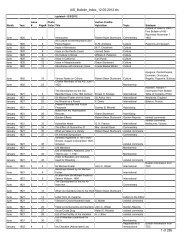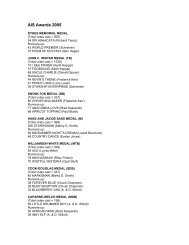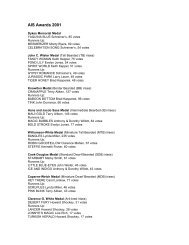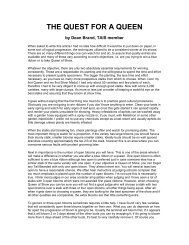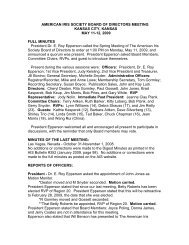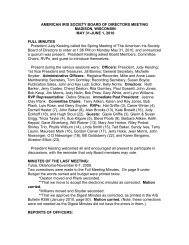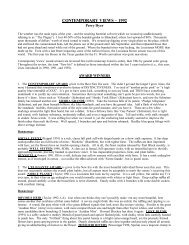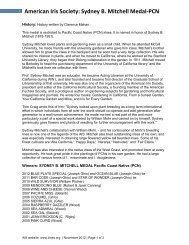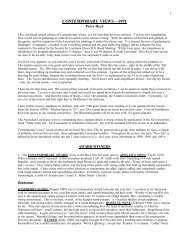contemporary views – 1988 award winners - American Iris Society
contemporary views – 1988 award winners - American Iris Society
contemporary views – 1988 award winners - American Iris Society
Create successful ePaper yourself
Turn your PDF publications into a flip-book with our unique Google optimized e-Paper software.
APRICOTS TO ORANGES:<br />
GOOD SHOW (Hager <strong>1988</strong>) is still far and above the best orange on the market today, yet incredibly still failed to even<br />
win an HM! A huge extrovert that has the strongest stalks and the best branching and bud count in the rich oranges.<br />
GRATUITY (Hager 1990), on a first-year bloom, showed great promise, and is an even deeper, richer shade of orange. Joe<br />
Ghio is doing some nice work in this color, and I finally got to see why ESMERALDA (<strong>1988</strong>) is so popular. It is a<br />
smaller, shorter, heavily ruffled deep orange small-tall that Joe wisely changed to TB from its original BB classification.<br />
Some of the stalks here reach 36”, but most hover right about 30”. A magnificent show stalk of MONTEVIDEO (1987)<br />
was First Runnerup at the Dallas show this year. It is more of a medium orange with large, impressive flowers. FUN<br />
FEST (O. Brown <strong>1988</strong>) is another one of those that opens so late in the season that most of the public rarely gets to see it.<br />
In this early year, a grand stalk of it, entered by Perry Parrish, was a Runnerup to Best-of-Show at the Oklahoma <strong>Iris</strong><br />
<strong>Society</strong> show in Oklahoma City. It is an unusual shade of apricot-orange, in that it has a salmon underglow and poppy red<br />
beards. Heavy ruffles add zest to the fest. Howard Shockey, the “king of the arilbreds”, has produced another TB winner<br />
with PARFAIT DELIGHT (<strong>1988</strong>), a luscious confection of pastel apricots, creams, and pinks, with the falls slightly<br />
lighter in the center, then banded with the blended colors. The king of the garden in plant habits, with obscene, huge<br />
plants rivaling ‘Holy Night’ (Mohr).<br />
CLASSICS: HAYRIDE (B. Jones 1971); MANDARIN MOON (Moldovan 1970); SALMON DREAM (Rudolph<br />
1970).<br />
PINKS:<br />
SANDY ROSE (O. Brown <strong>1988</strong>) has been a sleeper. As with so many of Opal’s things, it is an extremely late bloomer.<br />
Very well named, it is literally a sandy rose with broad classy form and garnished with a beard in a pleasing shade of<br />
sienna coral. The entire flower is encapsulated in a burnished toasty look, remindful of the Ghio bloodline. BEAUTIFUL<br />
DREAMER (Hamblen <strong>1988</strong>) is also a late bloomer with silken pink and ivory shadings, somewhat lighter in the heart of<br />
the flower. Unobtrusive and smaller in stature, but with typically-incredible Hamblen branching. A trio of Gatty pinks is<br />
worth another review. Each is slightly different in intensity and flower form, and distinctive enough to each be worthy of a<br />
place in your garden: FRENCH PASTRY (1987) is a soft cotton candy pink with powdered sugar dusting in the falls.<br />
Broad and heavily ruffled. SATIN SIREN (1987) is a rich medium pink, a cleaner ‘Triple Crown’ (Dyer) with good<br />
plants that are quite resistant to leaf spot. The deepest, and my favorite, is FEMME FATALE (<strong>1988</strong>), a naughty<br />
presentation of hot pink <strong>–</strong> almost as deep as ‘Warm Embrace’ (Dyer) <strong>–</strong> with x-rated ruffling and lace on a full-formed<br />
bodice of sensuous pink. We’ve come a long way from ‘Cherie’ (Hall)!<br />
CLASSICS: PAINTED PINK (Plough 1971); PINK PIROUETTE (Newhard 1970); PRINCESS (Gatty 1972);<br />
WOODLAND ROSE (O. Brown 1970).<br />
LAVENDERS TO VIOLETS:<br />
DESIGNER’S RAGE (Black 1991) is such a unique color it’s hard to decide where to even put it in the review, unless<br />
you’d stick it in Potpourri! A transcendental crushed velvet in smoked mauve, creamed raspberry, diamond dusted rosy<br />
mauve …. YOU try to describe it. Don’t bother to look it up in the color charts <strong>–</strong> it ain’t there! This wide, shapely color<br />
gem is my favorite and the most unique of my friend, Paul Black’s, innovative breeding program. A deep burnt sienna<br />
beard just adds to the captivation. With admittedly inconsistent branching and bud count, one can nonetheless take this<br />
melting pot of bloodlines and further confuse the issue with the Hamblen, Ghio, Keppel, Opal Brown, and Shoop lines.<br />
That’s my plan…and a couple of other ventures not to be discussed! DRIFTING ALONG (O. Brown <strong>1988</strong>) is another<br />
that’s difficult to “categorize”. A soft blend of gentle lilac and blue, lighter in the falls, and all diamond dusted. The light<br />
coral beards and delicate lace do not break the ambiance. FARAWAY PLACES (Keppel <strong>1988</strong>) is a sultry, muted, mulled<br />
wine to rose, with suggestions of apricot across the falls that add to the mystery. Rich terra-cotta to sienna beards are an<br />
asset. It is heavily ruffled and has a strange “rolled-back” look in the falls.<br />
CLASSICS: CARO NOME (B. Brown 1970); FOND WISH (E. Smith 1967); LAURIE (Gaulter 1966).<br />
DEEP VIOLETS TO BLACKS:<br />
A couple of new additions were most worthy, in addition to 2 nice ones reviewed last year: GYRO (Aitken 1989) and<br />
MY SHADOW (Magee 1990). EVENING SILK (Aitken 1990) was very popular at Paul Black’s the day of the Sooner<br />
State bus tour. A rich, wide, lightly waved silky near-black with all the great stalk and plant habits of its parent,<br />
‘Superstition’ (Schreiner), but with much smoother hafts and deeper intensity of color saturation. A child of the great<br />
44



